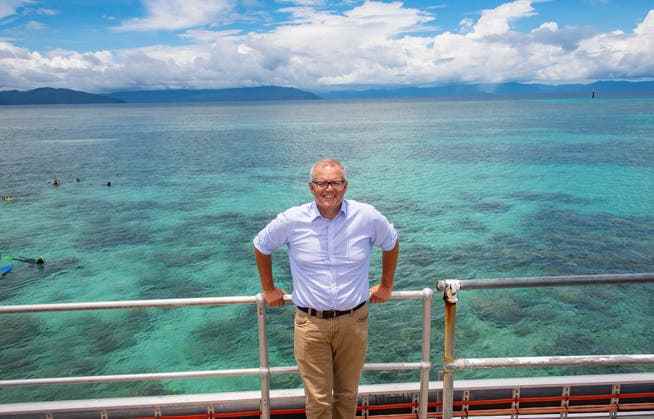The largest coral reef in the world is recovering, but there is still no all-clear. Global warming could quickly reverse the recovery.
The warmer the sea gets, the more the coral suffers.
The death of the world’s largest coral reef has been making negative headlines for years. Now, for once, there is good news: The Great Barrier Reef has more coral than it has been in 36 years.
That comes from one report of the Australian Institute of Marine Science, which is part of a long-term study is published every year.
Coral coverage currently averages 36 percent of the reef in the north and 33 percent in the center. These are record values. Until a few years ago, the reefs in this region were only 13 to 14 percent covered.
But that’s the only positive aspect. The recovery could quickly be reversed by global warming.
Because the corals, which increase the population on the reef due to their rapid growth, are particularly sensitive to heat and storms. They are also the preferred prey of the crown-of-thorns starfish – and there are more and more of them the warmer it gets.
The report says there will be more frequent and prolonged ocean heat waves in the future. The reason for this is climate change, which is the greatest threat to the reef in the long term. Therefore, urgent measures must be taken.
First bleaching during La Niña
“The fact that we’ve had four bleaching events in the last seven years, and one in a La Niña year for the first time, is worrying,” Mike Emslie, head of the long-term study at the Australian Institute of Marine Science, told the Guardian.
The first mass bleaching on the reef was recorded in 1998, since then the corals have been attacked again in 2002, 2016, 2017, 2020 and 2022. The more frequent bleaching occurs, the more difficult it is for corals to recover over the long term.
Earlier this year also saw the first bleaching event in a La Niña year. The global climate phenomenon began last autumn and is likely to continue over the coming months. Normally, unlike El Niño, La Niña brings precipitation and cooling to the Great Barrier Reef – and with it a welcome relief from otherwise very high summer temperatures.
On Australia’s east coast, in Queensland and New South Wales, where the reef stretches more than 2300 kilometers along the coast, there was a lot of rain, but the cool conditions could not last and the sea did not cool, so that despite La Niña came to a bleach.
Damage only becomes apparent in a few months
In order to examine the corals and determine the degree of bleaching, experts regularly dive over the reef or fly over it with helicopters for examination.
If it can also be seen from the air that the corals are white or fluorescent pink, yellow and blue, the bleaching is considered to be very advanced. By changing their color, they try to protect their tissues from the heat and sun.
However, half of the 87 reefs surveyed for the report were visited prior to the recent bleaching. “Their impact will only become apparent in the next few months,” Emslie, who led the study, told the Guardian.
Although the heat did not lead to the acute death of the corals, Emslie says that so-called “sublethal” effects could occur later. While the corals are bleaching, they are still alive but are starving – and this could affect their ability to reproduce and grow in the long term.
Save the reef with money
The most recent bleaching in March 2022 coincided with a visit by a UN delegation to the Australian state of Queensland to get an idea of the devastating effects of climate change on the Great Barrier Reef. Among other things, the scientists are to report to the UN World Heritage Committee.
The visit was prompted by Australian Prime Minister Scott Morrison, who wants to prevent the reef from being placed on the “World Heritage in Danger” list. In January, the government pledged an additional Australian dollar for the protection of the Great Barrier Reef – also to save tourism.

Australian Prime Minister Scott Morrison visited Green Island on the Great Barrier Reef in January 2022 to launch a reef rescue package.
The UNESCO World Heritage Committee will decide at its next meeting whether the reef will be included in the list or not. It is still unclear when this will take place.
Australia’s responsible authority downgraded the reef’s long-term prospects from “poor” to “very poor” back in 2019.
